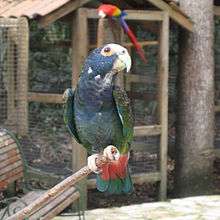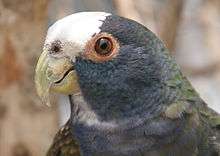White-crowned parrot
The white-crowned parrot (Pionus senilis), also known as the white-crowned pionus in aviculture, is a small parrot which is a resident breeding species from eastern Mexico to western Panama.
| White-crowned parrot | |
|---|---|
 | |
| At Macaw Mountain Bird Park, Honduras | |
| Scientific classification | |
| Kingdom: | Animalia |
| Phylum: | Chordata |
| Class: | Aves |
| Order: | Psittaciformes |
| Family: | Psittacidae |
| Genus: | Pionus |
| Species: | P. senilis |
| Binomial name | |
| Pionus senilis (Spix, 1824) | |
It is found in lowlands and foothills locally up to 1600 m altitude in forest canopy and edges, and adjacent semi-open woodland and second growth. The 3-6 white eggs are laid in an unlined nest, usually a natural cavity in a tree or a hollow palm stub.
The white-crowned parrot is 24 cm long and weighs 220 g. The adult male has a white forehead and crown, the feature which, likened to an old man's white hair, gave rise to the specific name senilis. The throat is white, and the rest of the head, neck and breast are dull dark blue. The belly is light green, and the upperparts are dark green, with a yellow-olive shoulder patch. In flight, the blue underwings and red vent are conspicuous features.
The female white-crowned parrot is similar to the male, but the blue plumage fades into scaling on the lower breast and the shoulder patch is duller. Young birds have little blue on the head and neck or red on the undertail, and the crown feathers are green edged with white. The extent of the area of white on the head gives no indication of gender, as there can be considerable variance in individuals.
The white-crowned parrot feeds in social flocks of 30-50 birds, which may wander outside the breeding range once nesting has finished. It feeds on taking various seeds, nuts and fruits, and can be pest in crops of corn or sorghum, and commercial fruit plantations.
It can be unobtrusive when feeding since it is slow-moving, usually silent, and keeps in the canopy. However, at rest it often perches conspicuously at the top of an unopened palm frond.

References
- BirdLife International (2012). "Pionus senilis". IUCN Red List of Threatened Species. 2012. Retrieved 26 November 2013.CS1 maint: ref=harv (link)
- Stiles and Skutch, A guide to the birds of Costa Rica ISBN 0-8014-9600-4
External links
| Wikimedia Commons has media related to Pionus senilis. |
